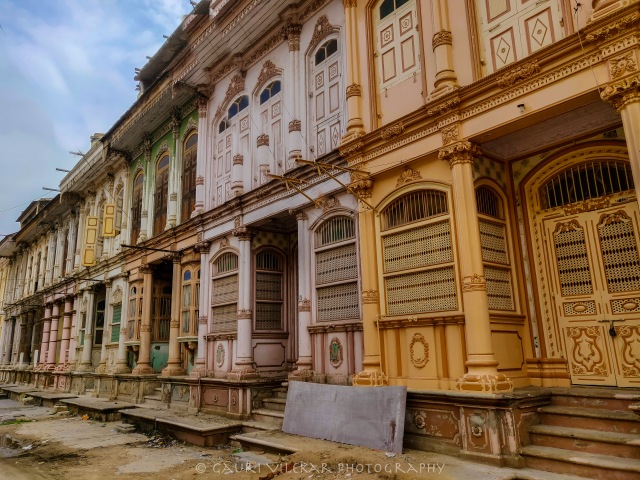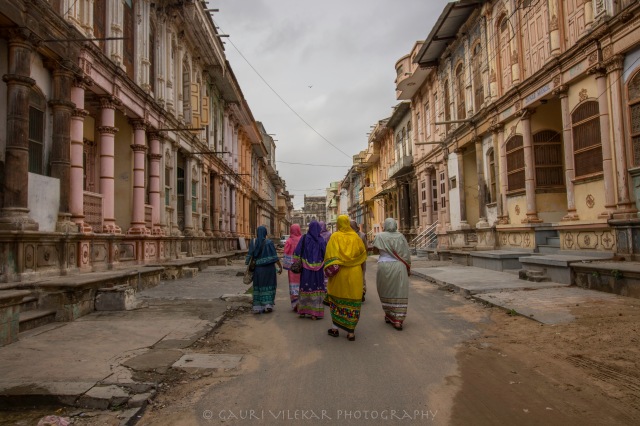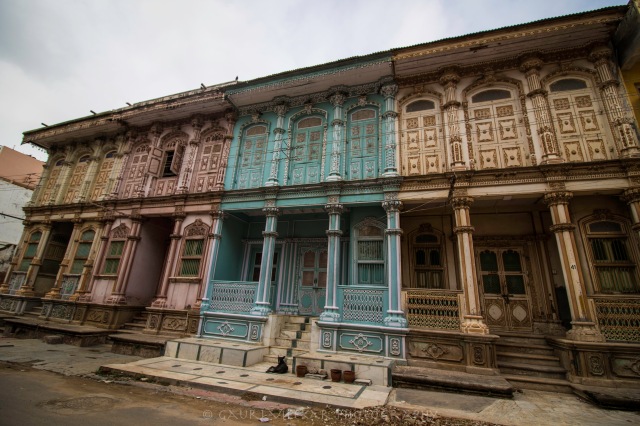The crumbling Vohrawad

The colossal ‘Haveli’ with its 365 windows had gathered moss and blackened with time. With white paint peeling off from everywhere, it looked eerie as it stood at the corner of an empty crossroad. The owner, a wealthy businessman had shifted to South India for better prospects, leaving the Haveli to die a silent death. Ironically, little did he realise that the true worth of what he was neglecting was far beyond all the wealth that he possessed. And the ones who do, can only admire and shake their heads in hopelessness.

Siddhpur, about 30 kilometres away from Patan in Gujarat, looked like any other normal town, until I reached Vohrawad, where the atmosphere changed from chaos to muteness with the blink of an eye. It was not just the Haveli, but the entire colony of Vohrawad that stood abandoned!


My mind raced with questions, but there was no one around to answers them. Around four or five lanes ran parallel to the Haveli intersecting the main street at right angles. Every lane had an unending string of houses on both sides built in a typical Victorian architecture with intricate floral designs on the walls and doors and were painted in contrasting but subdued shades of yellows, greens, blues and pinks. Each houses shared a common wall with the one next to it. The houses were so identical, that, if not for the color, one could never distinguish one from the other! Every house had a distinguished stamp-like emblem with artistic freestyle drawing of the owner’s initials inscribed on the front wall.
Hover over each image for description
There was one thing unanimous to the entire framework though- they were all EMPTY! Barring a few, the rest were secured with huge locks. With pigeon and bat droppings on the stairs and porches, cobwebs and rust on the grills and windows, it was evident that the owners rarely visited. As I walked through the alleys, I could imagine the houses and streets come alive and scream through the deafening silence. Just then, the loud chit-chat of a group of Bohri women clad in bright Burkhas pierced through, as they walked past me and disappeared into a house a few blocks ahead.

I finally bumped into a man, somewhere in his late fifties, inspecting a teal colored house that was being renovated. “These houses belong to the Bohra community and every house is at-least hundred years old, some even older. The Bohris gradually left Vohrawad and their ancestral homes behind and migrated to major cities around India for better business prospects and a better way of life. Only a few families have remained. Most of them visit once a year or so to inspect their houses and return. But let me tell you, nobody will ever sell their houses, unless hell breaks loose on them”, he explained with pride. I took the opportunity to quickly sneak into the interiors of the house that was being refurbished. It was dingy inside with crumbling walls. Under all the cement and debris, I could see the exquisite mosaic patterns of the floor tiles. The hall had antique wooden furniture and a long wall-mounted mirror with wooden frame. Steep wooden stairs led to the second and third floors which had spacious bedrooms and balconies. As I made my way up, it was like entering a time machine which pulled me into the era before independence. I did not dare to take the final set of fragile iron steps that led to the terrace in the fear that it could collapse any moment! As I returned through the creepy and dark hallway back to the main door, I felt like I had hopped in and outside two antithetical worlds in a snap!

The market place of Vohrawad was brimming with people and vehicles. It was in stark contrast to the lifeless lanes that I had left behind minutes ago. I met a man by the name Taha Madraswala and his father who were kind enough to stitch the missing pieces of the puzzle.
The Solanki Kings, during their rule, had rented out the acquired land to the Bohras at a nominal rent but with a condition that all the houses built in the community should have the same height and structure. There is a possibility that all these houses were built almost at the same time, but colored differently for easy identification. Bohras were primarily a Muslim trading community that traded mostly with European countries and hence the European influence is evidently visible in the architecture. Though built lavishly, there was a major flaw in their construct with respect to drainage and sanitation. Interestingly, the ancestral houses are now owned by the families, but the ownership of the land is vested with the government!


The present state of Vohrawad is rather depressing -crumbling walls, collapsing pillars, leaking roofs and broken drain pipes. Vohrawad was a place with no grandeur, no royal palaces, no striking landscapes and no cultural extravaganza. But it will remain etched in my memory for nothing else but sheer nothingness.






Lovely account of the Havelis! Awesome pictures too!
LikeLike
Thank you Satish!
LikeLike